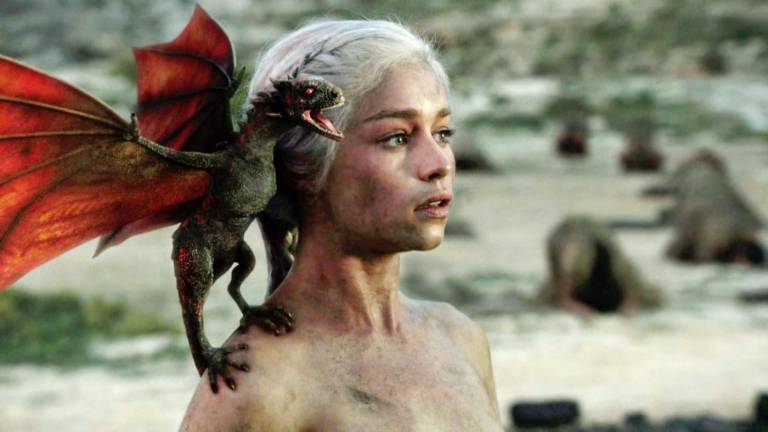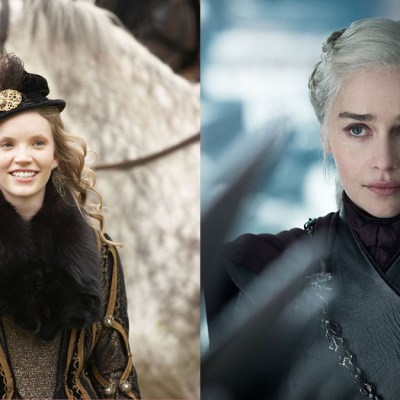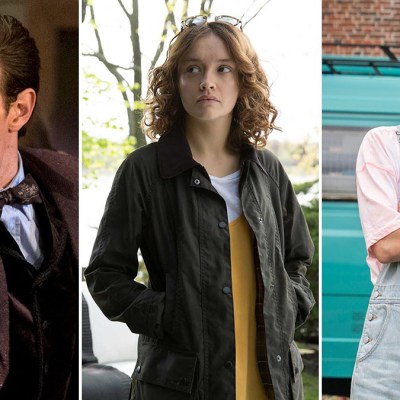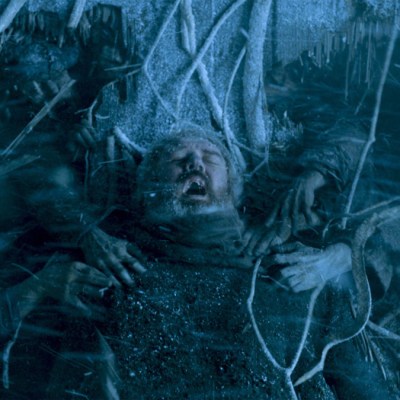Game of Thrones at 10: The Series That Changed TV Forever
It’s been 10 years since Game of Thrones opened the gates to Westeros. What does its phenomenal popularity mean now?

During the Game of Thrones series finale, there’s an exchange between Jon Snow and Tyrion Lannister that is as much about the series’ legacy as it is the characters’ inner turmoil. Only a handful of scenes earlier, these same two men conspired to murder the woman they called their queen, Daenerys Targaryen. Now living with the consequences of that heavy deed—with Jon again banished to the white hell Beyond the Wall and Tyrion conscripted to a lifetime of public service—a tormented Jon asks his friend was it right what they did?
“Ask me again in 10 years,” Tyrion says tersely. After all these years, the craftiest of Lannisters finally has learned he doesn’t know what he doesn’t know—and who really knows how the decisions in the here and now will appear to posterity? It’s easy to speculate that showrunners David Benioff and D.B. Weiss felt the same way about their controversial ending to Game of Thrones. And like Tyrion and Jon, they probably could not anticipate the entire fallout that was to come.
It’s been two years since the contentious farewell to the series that defined its pop culture decade. But define it, it did. Running from 2011 to 2019, the show’s rise and fall traces eerily close to the rhythms of its era, perhaps more so than any series ever produced. It launched as the biggest gamble in premium cable history, and it ended as the most popular televised phenomenon of the 2010s. Some have argued Game of Thrones was the last of the “watercooler shows.” Even the divisiveness of its finale was monumental, shaping the next era of TV in still unseen ways. Pop culture really does live on in the realm forged by HBO’s fire and blood.
So while it hasn’t been a full 10 years since Tyrion dodged Jon’s question, a decade has passed from the moment three riders in black emerged from an icy gate, and Game of Thrones premiered on HBO. That’s more than enough time to ask what did Game of Thrones mean to us and the television landscape it shaped?
The Coming of Winter
Television was a different universe in April 2011. Netflix was still that mail rental/streaming company which didn’t produce its own content, storytelling was full of cynicism, and cable television remained king. But within that fiefdom, HBO was facing a problem: the once undisputed ruler of premium cable drama was now seeing challengers for its throne.
“HBO was still coming out of The Sopranos, The Wire, and Deadwood,” Michael Lombardo, then-HBO programming president, told James Hibberd for Fire Cannot Kill a Dragon, an oral history on the making of the series. “We were getting questions like, ‘Why did you not get Mad Men? How come you didn’t pick up Breaking Bad?’ We had been the place for all things quality drama and were looking to regain our footing. But Game of Thrones didn’t seem to fall into our category.”
In retrospect, it obviously should have. Based on George R.R. Martin’s sprawling A Song of Ice and Fire book series, the show was pitched (somewhat inaccurately) as The Sopranos meets Lord of the Rings. Martin may have written his novels to be unfilmable, but at HBO, Benioff and Weiss would create an impressive facsimile of his Westeros on a budget.
Very much a product of its time, Game of Thrones came out at the tail-end of the “antihero” era of television, the period where HBO led the way in populating TV with flawed if not outright repugnant protagonists. A reaction to television being defined by network censorship for all the decades before the 21st century, the sliding spectrum of lapsed morality between Don Draper (Mad Men) and Tony Soprano was exhilarating in its time. But unlike all those series, Game of Thrones was offering a vast tapestry of protagonists in its ensemble, which provided an even greater range of moral complexity than most popular American shows at that time.
There were fantasy stalwart heroes like Lord Eddard Stark (Sean Bean) and his oldest sons, but also enigmas such as Daenerys Targaryen (Emilia Clarke), antiheroes who were introduced as full-on villains (read: most of the Lannisters), and young heroines whose nigh transcendentalist adventures belied darker traumas, such as Arya Stark (Maisie Williams). It was both of its moment and a far cry from the cynicism of other popular shows, not to mention the popular image of fantasy, which on the small screen was closer to Xena: Warrior Princess than Lord of the Rings.
“There were a fair number of reasons not to do it,” Carolyn Strauss told Hibberd about the show’s early days at HBO. As the former HBO programming president who first greenlit the Game of Thrones pilot, and then became executive producer on the series, Strauss can recall the apprehension she felt toward the idea of making a fantasy series for adults. “There are many ways a fantasy series can go south. Any show that relies on a mythology that isn’t thought out in enormous detail can go off the rails. You’re maybe good for a season or two, and then after that you start running into brick walls.”
Yet it was Thrones’ moral complexity in such a dense, heightened world that caught Strauss off-guard. “The way [Benioff and Weiss] told the story in the meeting made it sound much more involved and character-driven than I usually feel from fantasy stories. It was not good vs. evil, but characters who had elements of both things.”
That level of nuance was shocking when Game of Thrones premiered in 2011. Nowadays the series is often reduced by TV critics as being simply the show that introduced convincing blockbuster spectacle to the small screen. But in its early seasons that really wasn’t the case. While Benioff and Weiss were quietly aware of how massive in scope Martin’s novels eventually became, they sold the series to HBO as a “chamber piece,” not a symphony. It’s about intimate family drama—at least in the first season/novel—not magic and battles.
In that first episode, there was hardly an unsullied viewer who didn’t gasp when sweet 10-year-old Bran Stark (Isaac Hempstead-Wright) was pushed out a window by Jaime Lannister (Nikolaj Coster-Waldau). The thrill wasn’t seeing dragons lay waste to armies; the excitement was found in character moments or decisions with drastic repercussions on every other scene that followed. At its heart, it was a fantasy series drenched in human psychology and human history (particularly that of the English War of the Roses), and those hooks made the eventual ice and fire spectacle that much more extraordinary five years down the line.
Game of Thrones didn’t come out of the gate as a culture defining event—its series premiere netted just 2.2 million viewers, about 1.6 million less than HBO’s similarly epic and ill-fated Rome—but like the armies of one silver haired queen from the east, it’s rise seemed blessed to gradually, and unwaveringly, build until the bloody end.
A Golden Crown
The moment that personally got me wholeheartedly invested into Game of Thrones, however, wasn’t Bran’s fall from a Winterfell tower, nor was it Peter Dinklage’s Tyrion verbally humiliating his demon seed nephew. The scene where the show fully clicked was in the sixth episode, “A Golden Crown.” Up until that moment, the series was dense on world-building and lore, but the narrative was so finely tuned, and hidden in such a tightly wound coil, that it could feel impenetrable at first blush. It also seemed to be built on a certain set of fantasy archetypes, such as the noble hero Ned Stark and the old fat king, Robert (Mark Addy).
Another seeming archetype was Viserys Targaryen, a malicious blonde-haired misanthrope played so ably by Harry Lloyd that one would recoil when he was on screen. Technically, he’s a lonely exiled prince whose family lost its dynasty. But as seen through the eyes of Clarke’s put-upon and abused Daenerys, Viserys’ younger sister whom he mercilessly abused, Viserys was really just an ugly bully. The kind you might imagine Harry Potter’s Draco Malfoy growing into, except with the creepy addition of a leering, incestuous gaze. Also like Draco, I feared Dany would have to endure his pestering for the rest of the series.
Then “A Golden Crown” occurs, and Viserys is plucked from the series like leaden dead weight. Moments before his death, Viserys has realized that no matter how much he calls himself king, no one will follow him. Meanwhile Dany has won the hearts of the Dothraki, a nomadic warrior culture. She now rules as their Khaleesi (queen) alongside Khal Drogo (Jason Momoa), the husband Viserys sold her to. Viserys expected Drogo to become his mercenary, but by episode 6, that obviously is never going to happen. So his simmering resentment seemed to suggest Viserys would undermine Dany’s fledgling power and character growth at every future opportunity. But at the end of “The Golden Crown,” the self-styled king threatens Daenerys before the whole Dothraki court, and perhaps more chillingly in Dany’s eyes, threatens to cut out the baby growing inside her womb if he does not get his way.
Drogo ultimately gives Viserys what he wants: a crown. Only it’s made from the molten hot liquid gold he’s melted down to pour on the wretch’s head. Daenerys watches the gold slowly boil before the deed is done, and she sees her brother begging for his life. But the moment he raised her hand against her unborn child, the man was already dead to her. After Viserys’ head is crushed by the burning gold running through his skull, she doesn’t even blink. Rather Clarke says with maximum disaffection, “He was no dragon. Fire cannot kill a dragon.”
This hard left turn in the plotting was so sudden and shocking that it signaled what the series would become: a narrative where every character’s action and decision (at least pre-season 7) had potent consequences. Narrative conventions could be cut short in an instance. In this case, it was one that left viewers thrilled, but a few episodes later the same creative instinct would shatter them when the series’ main lead, poor Ned, lost his head. Such twists led me to buy all of Martin’s books and read them within a few months.
However, there was something more unsettling about the sequence. Daenerys Targaryen, our ostensible hero in her own storyline, did not flinch or bat an eye at her brother’s demise. He was rotten to the core, but Dany was no more affected by his death than she would be at the sight of hundreds of strangers crucified along a road on her order (an event which would occur later in the series).
The ambiguity of some of these characters, including Dany who in the early seasons was initially presented as an impending threat to the Starks and Lannisters a world away in Westeros, is what gave the drama so much life. There were reasons to root for nearly every faction and reasons to have pause with each character. You knew, eventually, your favorites would be in mortal conflict. While featuring a greater array of heroes than any of the other popular cable shows of the early 2010s, Game of Thrones also wallowed in moral relativity and bleakness. In 2011, it was like a high; in 2021, that kind of televised storytelling has largely fallen out of popularity.
Thrones also had a hand in that shift.
“Tits and Dragons”
For all of Game of Thrones’ good qualities, they cannot be extracted from its sins. Ten years ago, premium cable networks indulged in heavy use of obligatory nudity (mostly of young women) to keep viewers watching. Game of Thrones didn’t invent this, but it pushed it to its limit in the early seasons, even leading to the new term of “sexposition,” which describes when a show cynically includes images of naked women, usually portrayed as prostitutes in Thrones’ case, in the background during dry exposition.
Even before Thrones ended, these elements had aged badly, and were notably toned down in the later seasons. But they still occurred, even as gags, up to and including the final year. Neil Marshall, who directed two battle episodes on the series, even recalled in 2012 a disquieting note he received from an executive on the episode “Blackwater.”
“This particular exec took me to one side and said, ‘Look, I represent the pervert side of the audience okay?’” Marshall said. “‘Everybody else is the serious drama side, [but] I represent the perv side of the audience, and I’m saying I want full frontal nudity in this scene.’”
This cavalier attitude about using (some might say exploiting) young actresses who are anxious for a job on a popular series in such a gratuitous way contributed to the creation of a new profession in Hollywood: the intimacy coordinator. The actual HBO series which finally triggered this was The Deuce, not Game of Thrones. Still, Thrones most famously contributed to that sensationalism on television. So much so one of its most lauded guest stars, Ian McShane, deadpanned the show was only about “tits and dragons.” It became the figurehead for a media culture so problematic that there needed to be a reckoning at all networks and streamers in the post-#MeToo era.
That those elements on Game of Thrones were so often used in association with rape or sexual violence has led to a long overdue reevaluation of how stories with women are told in popular media—particularly from writers’ rooms dominated by men.
In truth, Game of Thrones has a litany of fascinating and complex female characters, many of whom end up in positions of power during the final seasons despite the grueling restraints of a medieval patriarchal society. Stars like Sophie Turner, whose Sansa Stark concludes the series as Queen in the North, has argued the series is actually quite feminist in its depiction of a wide range of nuanced female leads navigating medieval misogyny. And Clarke has said the show has taught her to “embrace her feminism.”
Yet both actors’ characters were forced to endure scenes of rape and sexual assault on the series, quite graphically in Clarke’s case during the first season. Even 10 years ago, viewers were rightfully disturbed by that. Clarke’s own thoughts on the use of nudity in the first season have also evolved. These elements, which only seem more glaring to the modern eye, have inspired a shift in how all “adult” stories are told, as well as how fantasy stories and historical dramas are received by audiences increasingly critical of one-sided titillation.
Those scenes likely contributed to the fan backlash when Clarke’s Daenerys, who suffered so much early on only to remake herself as a godlike savior, was revealed to be painfully mortal… turning into the villain of her own story.
A Legacy of Conflict
Game of Thrones began as a gamble for HBO, but even in its first year the bet was paying off when the fantasy show with dragons and ice zombies was nominated for Best Drama Series at the Emmys. Dinklage would go on to win his first of four Emmys for playing Tyrion that year, and even as the show lost the top prize then, it would eventually win Best Drama Series in four subsequent years.
It’s also worth noting that Dany’s dragons were barely present in the first season. Before the 2011 finale, they were creatures of a bygone age that, we’re told repeatedly, have long gone extinct. But in the final minutes of season 1, her ancient dragon eggs hatch, and a scene of biblical import plays out when she emerges from ashes as the Mother of Dragons. With each following year, Dany’s children grew larger in size, as did the pyrotechnics they unleashed. They were not much bigger than cats when they burned down a city of slavers in season 3. By the show’s end, they were the size of 747 jets while laying waste to Lannister armies.
As the creatures grew, so did Game of Thrones’ budget and, just as importantly, its audience. No other series in the modern era grew bigger with each season, from the cradle to its grave. In an age where Netflix invented the term “binge watching,” Game of Thrones remained the rare holdout of old school appointment television, with most audiences simultaneously watching live when the episode premiered on Sunday nights. Entire cottage industries based on fan speculation were born, and reading Martin’s books like they were sacred texts with hidden meanings that only the most learned scholar could translate became a pastime.
The first season premiered with 2.2 million people watching; the final season debuted with an audience of 17.4 million viewers. The finale brought in 19.3 million viewers. By comparison, the most popular scripted drama series on network television in 2019, This is Us, was averaging around 7-8 million viewers.
Yet as its popularity grew with its dragons, so did a vocal sense of dissatisfaction. There was a confluence of factors involved, many of them having to do with showrunners Benioff and Weiss running out of Martin novels to adapt. While they had a rough outline of how the series would end, the final two seasons of Game of Thrones arguably felt at points like just that: an outline the series was hitting by bullet point in each episode, often without the intricate plotting that made the early seasons and novels so addictive.
Yet it was really only during the series’ final two episodes, as a long built-up dragon fulfilled his destiny, that the rift between audience expectation and artistic intent erupted into a social media outrage. After watching Dany’s power build and build, and spending the final seasons with her pivoting from a threat to the Starks and King’s Landing to their ally against the Army of the Dead, Dany did what the series had long been famous for: she took a hard left turn.
In the final few hours of the series, Daenerys burns down the Westerosi capital, kills tens of thousands of people, and takes the Iron Throne in fire and blood, just like her ancestors. It was not the ending audiences, including myself, wanted for Dany, and it was an ending that disappointed even Clarke. Especially Clarke.
In many ways, it is one of the most Martin-esque elements of the series’ final years. You were promised high fantasy excitement and then got the cold, harsh reality of death and suffering. The fairy tales and fables which inspired modern fantasy are often derived from uglier histories and troubling sides of human nature. This is what conquest looks like, be it by dragon or sword.
Unfortunately, the execution of the ending left something to be desired. And there are plenty of write-ups out there to unpack the problems with the final season. Nonetheless, it is fair to wonder if for the first time in the series’ whole run, the show was finally out of step with the zeitgeist, and the subversion that was celebrated a decade earlier was no longer of the moment? When the show premiered, it was a realpolitik fantasy about the corrupting influence of power and how it can be wielded. When the series ended, corrupt abusers of power were on the rise around the world. Even Martin noted it was like King Joffrey had come to the White House.
The series not only denied viewers their favorite theories for the series’ end, but also a sense of escape from a world that was feeling uncomfortably closer to Westeros than it had eight years earlier.
In its own realm though, Game of Thrones was a series that shaped the modern television landscape. Spectacle on a scale comparable to Hollywood blockbusters is now deemed as attainable by content creators with deep enough pockets. Amazon paid $1 billion for the television rights of Lord of the Rings alone. But the industry has also reacted to Thrones and the antihero era it came from with a growing sense of wariness, too.
One of Game of Thrones’ contemporaries from its heyday was The Walking Dead. As another gritty, violent, and at times nihilistic genre show that became a mainstream hit, The Walking Dead started in the same TV season as Thrones. And one of its most pivotal writers from those earlier glory days, former showrunner Glen Mazzara, recently tweeted about the change in the industry’s tenor.
“TV development today is all about optimism,” Mazzara wrote. “Buyers don’t want anything dark or bleak.” While he then went on to add that he’s nonetheless writing the “darkest [and] scariest” thing of his career, the point remains that what was once the most popular thing on television, first as austere dramas and then as gory spectacles in shows like Thrones and The Walking Dead, is out of step in a modern TV landscape that has reacted to those shows.
Ironically, genre is more popular than ever, but the moral ambiguity and relativity that attracted HBO to Benioff and Weiss’ pitch is not. Rather than antiheroes, television is increasingly dominated by good natured and heroic individuals (Marvel Studios is even making the most popular shows). Characters, meanwhile, are proactively trying to solve social problems, not reveling in how broken things are. Creative spaces are also thankfully becoming more inclusive, giving a platform to a wider range of voices, including writers’ rooms where someone might be able to say the equivalent of, “You know, maybe Sansa shouldn’t be raped by Ramsay Bolton?”
This environment is a reaction to the popularity and then backlash endured by Game of Thrones. Which means our relationship to the series is far from over, even as the show’s run becomes an increasingly distant memory.
And yet, there’s (clearly) much to be said about what Game of Thrones accomplished in its time, right down to ending the way it did. It’s hard to imagine a show becoming that popular again and existing with such artistic freedom, and for its creators to be allowed to end it where they would like. Even in the 2010s it was rare, hence The Walking Dead lumbering onto an eleventh season this fall as a pale shadow of its former self. When that series ends, it also really won’t be the end, with more spinoffs, movies, and other forms of content planned.
Under new management, HBO has signaled they’ve developed a similar temperament, even with Game of Thrones. Benioff, Weiss, and apparently Martin saw their story end exactly the way they wanted to (even if few agreed with them). But the network has announced five live-action spinoff series in various stages of development, plus an animated one on HBO Max. In the age of endless streaming content, it’s easy to imagine that every corner of Westerosi history will be explored if WarnerMedia thinks there is an appetite.
Our feelings toward the legacy of Game of Thrones have evolved over the last 10 years, and will likely continue to do so for another 10. But it was a show that hit the right beats at the right time, and changed the culture while doing so. It burned brightly and then snuffed out its candle on its own terms. You don’t have to wait a decade to appreciate how rare, and unforgettable, that really is.



